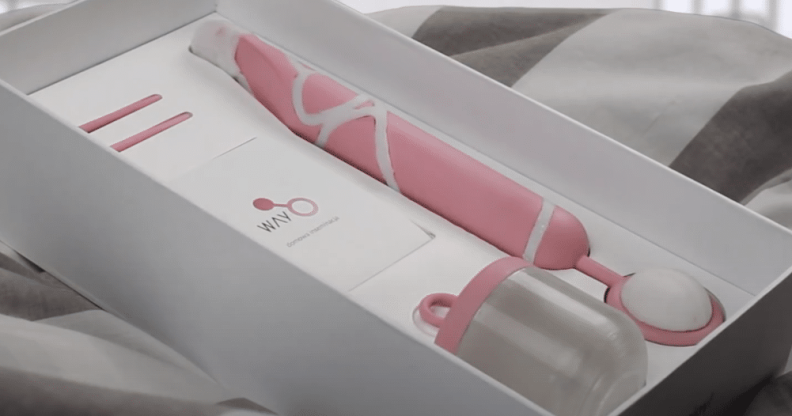Dildo-inspired insemination kit designed to make queer conception more intimate – and pleasurable

The Way home insemination kit. (YouTube/ Kamila Rudnicka)
A dildo-style home insemination kit is designed to make conception a pleasurable and intimate process for queer couples.
Even if queer couples decide to self-inseminate at home, the procedure can feel strange and clinical, but the Way device makes sure that there can still be fun when it comes to baby-making.
At first glance, the insemination device looks exactly like a minimalist, silicone, pink and white dildo. But on closer inspection, a small bubble is visible at the base, which is used to hold semen.
The kit comes with a jar, into which semen is deposited, before the user sucks it into the bubble. When inserted into the vagina during sex, the bubble can be pressed to release its contents.
The tubes through which the semen travels along the dildo can also be removed, and worn as a harness around the hand to inseminate the conceiving partner while fingering.
Way device designer Kamila Rudnicka, from Poland, told Dezeen: “Hands are very important when we are making love, especially in lesbian sex.
“That’s why I decided to use them to connect two people. Just using a device will not give them the same feeling as using their own body during sex.”
While the Way clearly makes for a more pleasurable insemination experience for the conceiving partner, it also allows the non-conceiving partner to feel part of the process.
During the design process, Rudnicka said she consulted with gynaecologists and psychologists, and also interviewed potentials customers.
She said: “I wanted to create a device that would help them focus on something other than just getting pregnant.
“In a survey I did of couples, the majority said that even if at-home insemination can be less effective they still want to try it in their own bed.”
Although home insemination is a great option for many couples, it is not always as effective as other methods like intrauterine insemination (IUI) and in vitro insemination (IVF), which can be better choices for those struggling with fertility.
Rudnicka explained: “This is not a device for people who have been trying to get pregnant for years.
“It’s for couples where one side has HIV, for lesbian couples, transgender people and those with disabilities – people who are unable to conceive during their regular sexual activity… The hope is to make it a ‘first step’ people can take before resorting to the sterile medical procedure at the hospital.”
The Way is not yet on the market, and is still in the prototype phase, but the designer hopes it will be available for purchase in the near future.

